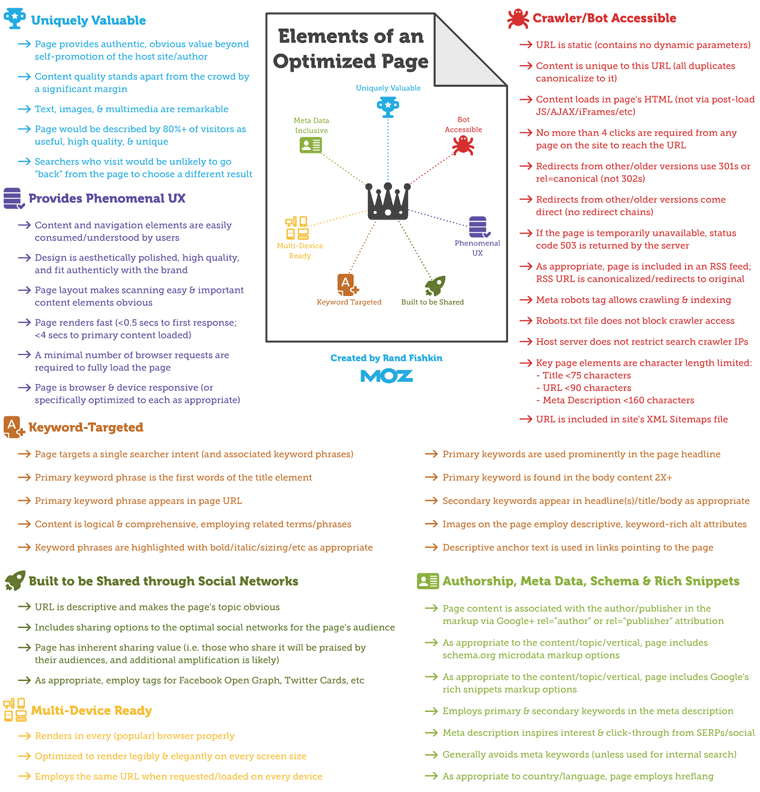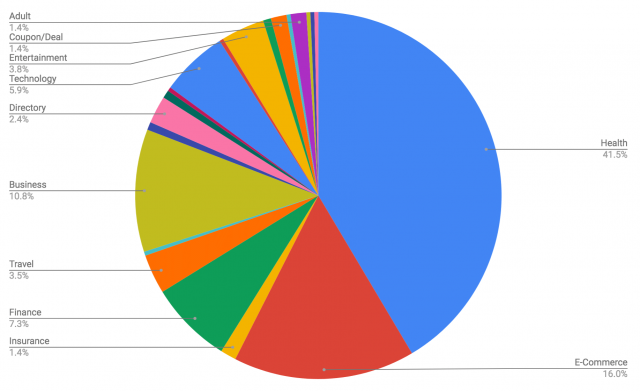In the field of SEO, it’s safe to say that things are always changing.
Optimization techniques that worked years ago fall by the wayside, and SEO as a whole evolves into a more intelligent discipline that evolves beyond spamming Google with links and keywords.
Sophisticated strategies for increasing organic traffic exist, along with things like competitor gap analysis, keyword gap analysis, and so on.
There are a number of strategies that one must use to be successful in the ever-increasing competitive landscape in SEO.
The Absolute Nuts & Bolts Basics
There are four basic components of SEO that we all focus on as a daily part of our jobs. These components include:
- Keywords (and keyword targeting).
- Search volumes behind keywords.
- Traffic coming from organic search.
- Conversions of customers searching for our targeted keywords.
The actual techniques revolve around the following:
- On-page optimization.
- Link building.
- Content.
- Technical SEO.
These are all a focus of our professions as we report on our efforts and assess next steps in any SEO campaign.
How do you move forward through a campaign and make sure that these factors are nailed down sufficiently enough for you to either launch or expand an existing campaign?
Well, you’ve come to the right place.
This SEO for beginners guide is designed to do exactly that, going through in detail the basics, in order to give you a solid foundation with which you can then use on your own.
Topics, Entities & Keywords
The first basic component we’re going to look at includes keywords and keyword targeting.
In the olden days of SEO, keywords were really all we had. Keywords and keyword targeting. Keyword targeting involved creating pages based on specific keywords and optimizing them.
The content would be laser-targeted and built around this keyword.
As you move forward with your SEO, you could technically include keyword synonyms, and related keywords in such a way that would help improve your rankings.
The problem with keywords, however, is that they can become redundant, too repetitive, and you can run out of SEO pain points in industry-related keywords fast.
There’s very little room to move forward.
For the process of keyword optimization, it used to be executed in the following way.
Say perhaps that you did keyword research, found the highest-performing ones in terms of search volume, created a page for the keyword, and ensured keywords were inter-weaved throughout your content accordingly. This was one way.
Let’s also not forget the different types of keywords, which are many. The goals of these keywords will change depending on how you want to approach your SEO:
- Money Keywords
- Head Keywords
- Short Tail keywords
- Long Tail Keywords
- Supporting Keywords / keyword synonyms
- Branded Keywords
- Phrase Match Keywords
- Broad Match Keywords
- Negative Keywords
- Exact Match Keywords
And many other keyword types. By the way, don’t get me started on LSI Keywords. Yes, they are a scam. And nothing more than a marketing attempt to brand synonyms and keyword relationships as something else.
That’s why LSI keywords are SEO snake oil.
Why are we going through such a detailed introduction of keywords? Because they are a fundamental skill of the SEO profession.
Recently however, there has been a shift from keywords to topics and entities.
If keywords are specific words and phrases, topics can be considered broader terms and concepts.
While there has been a shift, you still cannot do without keywords. They are the backbone of any SEO strategy.
A new wrench was thrown into the works with the introduction of entities. Just what’re entities, exactly?
Entities are places, persons, things. According to Dave Davies, entities are the world in the new SEO.
Davies says the following:
“Entities are, in my not-so-humble opinion, the single most important concept to understand in SEO right now. Full stop.
Think I’m just another SEO professional spouting the latest “silver bullet” that will die on the table along with many before it?
Consider this:
Three of the most important ranking factors, at last disclosure, were:
- Content
- Links
- RankBrain
An entity is anything that is:
- Singular
- Unique
- Well-defined
- Distinguishable”
And this is why it is so important to ensure that your site is optimized with entities, keywords, and topics.
Topics, Topics, Topics – So What’s the Deal with Topics?
Just what is the deal with topics? As mentioned previously, SEO is traditionally about optimizing for targeted keywords.
And it was – used to be – considered an SEO best practice to create 1 page per single targeted keyword.
You can come up with your topics by performing topic research using a tool like AnswerThePublic.com.
SEMrush also has its own tool called the topic research tool.
Using both of these tools, you should be able to uncover suitable topics for the type of website you are working on.
That’s all well and good, but what should you do if you are optimizing for multiple topics?
Kristopher Jones here on SEJ has a wonderful method on how to optimize your site for multiple topics in his post, How to Optimize Your Website for Multiple Topics.
There are other basics, including content, links, and technical SEO that will make or break your success.
Let’s take a look at some of the most defining factors that will help your SEO in 2020, and basic elements that you must learn.
High-Quality Content
Does Google’s algorithm suffer from issues when it comes to assessing whether or not content is of high enough quality?
It can, as this SEO found out recently when trying to game Google’s algorithm with Lorem ipsum text.
In general, high quality content is what’s going to help your site perform. But that takes on different forms depending on different attributes of your marketing campaign including:
- Your site’s main industry.
- What has been done to your site previously.
- What is being done to your site now.
- Your industry’s overall competition.
- What your competition is doing.
- What Google’s algorithm is doing.
Your site’s main industry
There are industry variations in SEO – no doubt about it. I highly suggest taking an open approach to SEO strategies, and not think that once you’ve learned a strategy, that you’re done. Not hardly.
Industry norms vary, and can be as different as the website itself. The way you find out about these norms is you should be doing a competitor gap analysis.
What a competitor gap analysis does is it will help you find what you need to do to increase those rankings above your competitor.
You can read more about how to perform a competitor gap analysis here.
The things that you’ll want to gain from your competitor gap analysis includes insights like:
- Your competitor’s rankings.
- Your competition’s content (frequency of posting, word counts, etc.).
- The link profiles of your competitors.
- And, to a lesser extent, on-page SEO and technical SEO.
Important: Correlation Is Not Causation
In SEO, you may think that if you make a slight change to some keywords on a site, or you make changes to some links, that an immediate improvement is perceptible, and likely due to that change.
The problem is that it seldom works out that way in the real world.
When it comes to SEO, correlation is not causation. It’s not enough to say that you did this, this, and this, and that that was a contributor to your results.
On the contrary, detailed organic traffic data analysis and interpretation is needed to find the full story.
That’s what makes SEO so complex – the fact that it’s not a simple correlation / causation paradigm.
Instead, SEO is far more complex with layers of algorithms, not to mention the fact that Google makes changes to their algorithms daily.
The ones they choose to announce just so happen to be the most devastating if you’re in any way engaging in spammy practices.
Which brings me to the following topic: white hat SEO vs. black hat SEO.
White Hat SEO vs. Black Hat SEO vs. Grey Hat: Which Hat Should I Choose?
In the field of SEO, there are different philosophies. These philosophies don’t always mesh well. In fact, they can be frustrating for SEOs the world over, because one group believes one thing while another group believes another.
White Hat SEOs follow Google’s Webmaster Guidelines to the letter. They believe in implementing techniques that will be sustainable for the long-term, and that won’t cause Google to levy a penalty against them.
The most ethical SEOs are those who provide their clients with everything that they do – they give details, they give the links they build, all of it.
They are ethical and transparent in their SEO duties, and provide reports that the client can take reasonable action on in the future.
Black Hat SEOs are not afraid to embrace the latest and greatest in techniques, regardless of how far astray they lead them from Google’s guidelines.
They are masters of a perpetual churn-and-burn machine, often getting great short-term results, but lacking in long-term results.
It is these Black Hat SEOs who use programs like Scrapebox, SENuke, and XRumer in an attempt to build links en masse, so that these links will, in turn, push their rankings to the #1 spot – until Google catches them and all hell breaks loose.
Then, they just start over with another domain.
Grey Hat is a healthy mix of the two, usually using black hat techniques for research but not execution, and using a white hat approach for sustainable results in the long-term. This is likely where most aggressive SEOs fall.
There’s nothing legally, morally, or inherently wrong with this, but if you want to stay on Google’s good side, you will want to choose white hat or grey hat SEO.
Perform Industry Research, Especially If You Are Not Familiar With Your Client’s Industry
Doing industry research is the first part.
Your primary source for such industry information should be your client. This is when you should perform some sort of discovery – and ask questions to determine any industry specifics that you should be aware of while doing SEO.
The next part would be figuring out the SEO elements that your competition is using to leverage their SERP performance.
If you can think of improving rankings and organic traffic as a core component of SEO, then the competitor gap analysis is a core component of assessing the next steps in an SEO campaign.
After looking into the industry, and defining your industry benchmarks, you will need to move forward with a site analysis.
This will help you uncover what has been done to the site previously, and what is being done to the site now.
It is imperative that you obtain this information, because one wrong step can cause you major issues in your SEO campaign later.
If you are lucky enough to be on a team that has this information, you can simply ask your team’s manager about the information and they should be able to give it to you on the spot.
However, if you are not quite as lucky, you may end up in the situation where you can’t assess that prior information.
In these cases, what is currently on the site is all you have, and you will have to think about your SEO campaign as moving forward from that point.
Your Competition’s Link Profiles Can Provide Valuable Insight
Your competition’s link profiles, along with your own, should also be a core component of this analysis.
But, this is where things can get dicey. If you don’t have a good grasp on SEO, what may seem to be obvious in terms of correlation may be entirely different when looked at from the POV of having everything.
This is where the dicey part comes in.
If you don’t do a link analysis, but there are other weaknesses, you may never be 100% certain what was responsible for improving the site.
On the other hand, if you have all of the information, you may still never be 100% sure, but at least you can narrow down the exact root cause of the improvement.
Remember, search is not a simple correlation – correlation is not causation. Just because you added one thing doesn’t mean that that one thing caused said improvement.
On-page SEO & Technical SEO Are Important Factors As Well
Other important factors you should be aware of include the latest in SEO techniques as they apply to on-page and technical SEO.
On-page optimization includes the following:
- Optimizing the page to deliver unique value.
- Optimization for phenomenal user experience (UX).
- Laser-targeted keyword targeting.
- Can easily be shared through the social networks.
- Can transition seamlessly between devices.
- Is crawler / bot accessible – Google’s Gary Illyes is on record as saying “Just make that damned site crawlable.”
- Optimizing for authorship, meta data, schema, and rich snippets.

Technical SEO
Technical SEO is heavily focused on the crawling and indexing of your site. This is where you can tilt the odds heavily in your favor by making sure your site is properly optimized for crawlers.
This doesn’t have anything to do with content or links, and is highly technical in its implementation.
Technical SEO in 2020 includes the following that you must learn and implement to be successful:
- Anything and everything to do with robots.txt.
- Optimization of your navigation and website’s architecture.
- URL structure optimization.
- Schema.org Structured Data implementation.
- Canonicalization of URLs.
- Error page analysis and correction (4xx, 5xx, 3xx, etc.).
- Server analysis for bottlenecks that can be costing you SERP performance.
- SSL implementation for a secure website.
- Page speed metrics along with individual SEO elements that increase page speed.
- Mobile-friendliness.
- Cross-browser and cross-platform compatibility.
- Code optimization (including W3C aspects like validation, accessibility, and so on).
- AMP for news publishers (which can cover a broad range of topics).
- International multilingual implementations.
- Pagination like next/prev.
- Internal links.
- Link Profile analysis to determine penalties or algorithmic adjustments (if any).
Our SEO ebooks can help, including my own book – The Ultimate SEO Audit Checklist.
Optimizing for Search Intent & Ensuring the Intent Matches the Target Query Precisely
You must target and successfully fulfill user intent in order for your optimization to be successful.
This is a basic SEO practice that has been in use since the early part of the 2010s decade.
You must make sure that your keywords highly meet the user intent for that query.
Dan Taylor here on SEJ writes:
“There have been a lot of studies conducted into understanding the intent behind a query; and this is reflected by the types of results that Google displays.
Google’s Paul Haahr gave a great presentation in 2016 looking at how Google returns results from a ranking engineer’s perspective. The same “highly meets” scale can be found in the Google Search Quality Rating Guidelines.
In the presentation, Haahr explains basic theories on how if a user is searching for a specific store (e.g., Walmart), they are most likely to be looking for their nearest Walmart store, not the brand’s head office in Arkansas.
The Search Quality Rating Guidelines echo this. Section 3 of the guidelines details the “Needs Met Rating Guidelines” and how to use them for content.
The scale ranges from Fully Meets (FullyM) to Fails to Meet (FailsM) and has flags for whether or not the content is porn, foreign language, not loading, or is upsetting/offensive.
The raters are not only critical of the websites they display in web results but also the special content result blocks (SCRB), aka Rich Snippets, and other search features that appear in addition to the “10 blue links”.”
Which brings us to another important consideration for SEO in 2020 – read and memorize the Google Search Quality Raters Guidelines – this is NOT to mean that you can go off and optimize what they say for organic search.
This is created by an entirely separate department from organic search. But, their manual contains important insights to understanding how Google overall views certain search factors that you can then translate into improving your overall E-A-T – Expertise, Authority, and Trust.
The following SEO factors you must know about are also important:
- Optimizing for page speed
- Strategic optimization of your target keywords (this includes within the page title, meta descriptions, H1s, and sub-heading tags)
- Page URL optimization
- Optimizing for page speed
- Image file size
- Image file names
- Alternative (alt) text
- Title Text
- See my article on image optimization for more.
- Write your content according to the intelligence level of your target audience
- Internal link optimization when creating a page of content
- Including images strategically throughout your text
E-A-T Your Content
Google’s core algorithm update of August 2018 had many people scrambling to understand what had destroyed their website so readily in the SERPs. It’s known as the medic update because it was believed that the update targeted medical sites.
When, in reality, it targeted YMYL (your money or your life) type sites as categorized in Google’s Quality Raters Guidelines.
In fact, it was one of the first updates where no SEO could figure out what happened within the first 60 days.
This update turned out to target the following types of sites:
- YMYL – Your Money or Your Life – sites
- Health sites
- Ecommerce
- Finance
- Business
- Technology
- Travel
- Entertainment
- Coupon / Deal sites
- Adult Sites

Why This Is Important
This update was a turning point in Google Algorithms that specifically targeted sites for long-term authority and trust. Yes, authority and trust is a big deal.
How do you build authority and trust? By answering the user’s query thoroughly, and mind-mapping your content to achieve this ultimate goal.
In 2020, if you want to build your own sites and make sure that they are SEO friendly, long-term sustainable SEO is even more of a consideration now.
Like Alan Bleiweiss writes elsewhere on Search Engine Journal, you must be the answer to the query.
Answer the user’s question so thoroughly that no one else can catch you competitively speaking.
Bleiweiss reports that mindset failure – or being unable to find what one needs – is a single critical factor you must get right to succeed in SEO.
“The industry needs to accept that if you look at most business sites, when it comes to their PRIMARY SERVICES or PRIMARY PRODUCT OFFERINGS, most of the important questions are stuck in a blog that is not:
- Well organized.
- Promoted on an industry or market scale.
- Discoverable when people are on those services or product pages.
And that is a big problem.
Yet if you insist on continuing with the whole “blogging” thing because “it’s what clients expect”, sure. Go for it. Have fun.
I’ll continue doing what I do when clients hire me to fix sites that broke, at least partly because of content failure.”
A Solid Focus on SEO Disciplines Is Needed to Succeed
You can’t expect to do SEO for a month and achieve amazing results overnight. Seldom does it happen this way.
Instead, you must implement a multi-pronged approach leading to a solid foundation that takes into account many issues across SEO elements to be successful.
A focus on any one thing will only lead to sub-par results that create nothing more than a blip in your Google Analytics data.
An organized approach that focuses on the ultimate in quality is best, while keeping in mind your user’s pain points, wants, needs, and desires as they relate their query.
Be the answer in your industry for your user’s query. And your SERP performance will thank you.
More Resources:
- SEO for Beginners: An Introduction to SEO Basics
- The Complete Guide to On-Page SEO
- SEO Fundamentals: Your Guide to SEO Success Factors
Image Credits
Featured Image: Created by author, January 2020
In-Post Image #1: Moz
In-Post Image #2: SERoundtable.com





